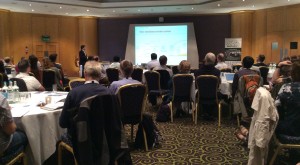
Third annual meeting science meeting
Our 3rd annual science meeting, held at the East Midlands Conference Centre, was attended by over 160 BioProNET members. As well as speakers from the UK, there was a strong international theme to the event; over half the speakers were international, and our two keynote speakers — Bill Barton and Pete Tessier— were from the USA. More details here.
Outreach events
BioProNET, together with the University of Kent, took part in the Big Bang Near Me and Chemistry at Work events, both of which aimed to inspire students to study STEM (science, technology, engineering and maths). At the events, students learned the difficulties in making antibody-based medicines by trying to make replica biologics out of modelling balloons. More details here.
Internationalisation meeting
The BioProNET internationalisation meeting had around 30 invited attendees from across Europe, and aimed to strengthen links within the international bioprocessing community.
Professor Ian Stansfield from the University of Aberdeen has recently been awarded funding
for a collaborative project investigating how to optimize the production of biologics, which was catalyzed by his participation at BioProNET events.
The production of vaccines, antibodies and other proteins in cell lines can induce cellular stress, which can lead to errors in translation — including ribosome frameshift errors. Such mistranslation can compromise the yield and quality of the protein product, and hence the safety and efficacy of biologics. Ian’s project will pursue a better understanding of causes of translational error through the design and application of novel reporters of mistranslation.
“Initial discussions on this project were started as a result of the BioProNET sandpit meeting, held in June 2015, when I made initial contact with a scientist from the biotechnology company Fujifilm Diosynth Biotechnologies,” says Ian.
As a result of this networking meeting, Ian co-organized a BioProNet-sponsored workshop on recombinant protein authenticity, together with colleagues Mick Tuite and Tobias von der Haar from the University of Kent. Ian commented “The attendance of scientists from Fujifilm at our BioProNET-sponsored workshop in London consolidated ideas for the project”.
The project includes collaboration partner Professor Phil Farabaugh, a molecular biologist from University of Maryland, USA, and physicist Dr Mamen Romano (University of Aberdeen) who will be mathematically modelling gene expression processes. Ian’s group will then use synthetic biology approaches to couple the output from the new mistranslation sensors to recombinant protein expression, in order to autoregulate mistranslation and the quality of the recombinant protein product.
Fujifilm will test these synthetic gene circuits in in yeast and E.coli to maximise the impact of this research on industrial biotechnology.
More about the project, which is jointly funded by the BBSRC (to Ian Stansfield and Mamen Romano) and the US National Science Foundation (to Phil Farabaugh) can be found here.

Over 75 BioProNET, BioCatNet and CBMNet members attended this joint NIBB (networks in industrial biotechnology and bioenergy) event, held on July 6th & 7th 2016 in Birmingham. After an introduction outlining the objectives of the event, attendees completed a ‘me profile’ describing who they were, their expertise, their dream project and what the next big development in their field of research could be. This was followed by a series of talks from academics and industry scientists in 3 sessions:
Protein trafficking in eukaryotic cells
Protein export from bacterial cell factories
Delivering therapeutic proteins and other compounds
Attendees then spent the rest of the day formulating potential project ideas and developing these new collaborations. This was then followed by a conference dinner where further networking took place, together with some football watching! The second day focused on ‘technology drivers’; after two talks attendees then moved into to groups to further develop project ideas. At the end of day two, 9 project ideas were generated and champions assigned to take these projects forward.
Proof of Concept funding from BioProNET has enabled Jim Warwicker and colleagues from the University to build a webtool that predicts protein solubility. Recombinant biologics often have low solubility, due to their high concentrations, sequence and three-dimensional structure. The accumulation of insoluble protein agglomerates can lead to the formation of aggregates, which can impact biological activity and immunogenicity of a biologic.
Therefore determining the solubility of a protein and its propensity of a protein to aggregate would be of great use to the biopharmaceutical industry and researchers.
The funding from BioProNET enabled Jim and colleagues to develop existing code into a user-friendly web format. Users (anyone!) can paste a single sequence of amino acids into the tool; the software compares this sequence to a benchmark dataset of proteins with known solubility, and then returns a set of calculations that predict solubility of the protein based on its sequence.
The programme calculates a variety of properties — such as amino acid composition, net predicted charge, predicted pI value, ratio of conservative amino acids, propensity for disorder, propensity for forming beta strands and sheets — that indicate how soluble the entered amino acid sequence is likely to be.
The webtool is available here:
http://www.protein-sol.manchester.ac.uk/
The project is already bearing fruit, as it has been used as part of a successful proposal to the EPSRC formulation call. The software is still under development and further improvements, including those based on user-feedback will be added.
Protein-Sol: A web tool for predicting protein solubility from sequence
Hebditch M, Alejandro Carballo-Amador M, Charonis S, Curtis R, Warwicker J.
Bioinformatics doi: 10.1093/bioinformatics/btx345 May 29 2017